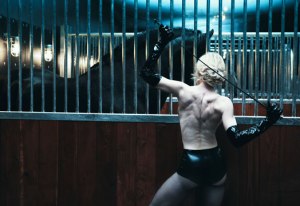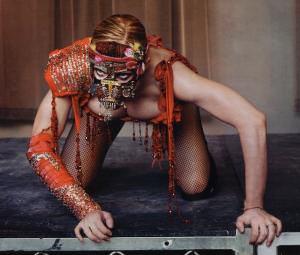[I did this interview with Steven Klein in Berlin, in 2005. It feels particularly relevant now, in light of his recent work with Madonna, so I thought I’d repost it.]
So what do a photographer and a writer, who, in their own ways, incorporate notions of fashion, fetish, and celebrity into their work, talk about? Do they talk about sex or fashion? Do they dish the dirt about which celebrity is harder to work with? Not really. Instead, they talk about identity, and what shapes it–and about art, and what isn’t.
So what isn’t art? In Steven Klein’s opinion, his work isn’t, which is ironic, since his current exhibition, X-STaTIC PRO=CeSS, has just opened at Berlin’s Camera Work gallery. The installation, which features a combination of photographs, video, and audio of Madonna in startling costumes and even more startling positions, originally debuted last year at New York City’s infamous Deitch Gallery (also home to some of Fischerspooner’s more extravagant performances), before traveling throughout the world, in an international array of art galleries and, in modified form, on massive screens during Madonna’s last tour.
A rather surprising succession of events for “not art.”
So if X-STaTIC PRO=CeSS isn’t art, then what is it? Art is separate from commerce, and his work is about commerce, Klein says, therefore his work isn’t art. Simple as that.
“So what is it?” I asked, thinking it can’t be that simple.
He thought for a moment. “Images.”
“Images? Then what separates it from wallpaper?”
“Nothing.”
If nothing separates Klein’s transgressive, controversial (occasionally banned in the USA) photographs of Brad Pitt, Pink, and almost anyone that’s anyone–or, better said, almost anyone with an image to subvert and deconstruct–from wallpaper, Laura Ashley might need to re-evaluate marketing strategy, as the home decorating market might be turned upside down.
So if his “images” aren’t art, why are they in galleries? Because that’s where they sell, he explained, and, bottom line, Klein is about selling–ideas, clothes, underwear, and repackaged pop icons–and sell his images do, making Klein one of the busiest fashion photographers working today. His client list features the best in the business, and it almost makes you wonder who hasn’t called him up–McQueen, Dsquared2, Calvin Klein, Yves Saint Laurent, Madonna all seem to want Klein to rebrand them.
And rebrand he does. Not with the glossy perfection of Herb Ritts or the happy healthiness of Bruce Weber, but in the post nuclear holocaust wasteland of KleinWorld, complete with barren landscapes, frequent fires, and abandoned warehouses in which the models are posed like awkward figurines and the lighting often appears a couple notches too harsh.
It seems like a lucky accident that Anna Wintour is such a Klein supporter, because it allows us to find his work in Vogue, and it allows Conde Nast to fund Klein’s various whims (fashion spreads, for instance, without clothing credits), and it’s hard not to be glad that Dolce and Gabbana hired Klein for their Summer campaign – after all, it enabled us to see what Klein does when told to “think Elvis.”
Ah, the fusion of fashion and art, perhaps as inevitable as the coupling of rockstar and supermodel! The accessibility of his work, and its commercial ties, may allow Klein to detach himself from the art scene, but does it really exclude his work with the same clean precision? His images may appear more often on the pages of Vogue than in galleries, but on the definition of art, I’d still have to disagree with him.
If, according to the Merriam-Webster dictionary, art is the “conscious use of skill and creative imagination especially in the production of aesthetic objects,” wouldn’t that include Klein, however unwillingly?
How appropriate that, when pressed to pick an icon, a mentor, someone whose work inspires him, the only name Klein mentions is Warhol, perhaps the man most well known for blurring the boundaries of what could be defined as art.
It’s ironic, because the same things that drive Klein to reinvent his medium, to re-evaluate his forms of communication, are perhaps the things that make him most relevant to artists today. A frustration with the limitations of painting, combined with a disdain for conventional approaches to photography, has allowed Klein to evolve into the installation artist he is now, preoccupied more with creating environments than with making pretty pictures. The time of Weston and Steiglitz is over; there is no sacred moment. For Klein and many of his contemporaries, the whole point is that nothing is sacred, especially celebrity status.
In today’s world, where popculture is consumed as quickly and as mindlessly as popcorn, we alternate between idolizing our stars and taking them apart, but one guarantee is that our celebrities will never have the same air of otherworldly perfection as in the days of Bogart and Bacall. We’re all too aware, thanks to tabloid thrills, that all that glitters is never real the morning after.
It’s this notion of celebrity construction that Klein delights in turning upon its head. He appears to take perverse pleasure in giving us our icons in bizarre, unexpected, and often disturbing positions–a seemingly possessed Brad Pitt, Madonna bent double upon herself, David Beckham being dominated by Victoria, David Bowie in a prison cell, or a bloodied Justin Timberlake .
Interestingly for a man who deconstructs icons with his work, Klein defines his own icons as people “who truly respect themselves, who achieve things through their own expression.”
So if expression is the name of the game, why the masks? Why the unconventional, artificial situations? Why the awkward yoga poses? And what is Klein really trying to say?
Klein’s primary mode of communication is imagery, stripping away the conventional mask of celebrity and replacing it with one of his own.
“I like to obscure people,” he says. “One mask replaces another, using images as a way of communicating something in me, in them.”
It as though when the pressure of being the perfect pop icon is lifted, the mask can actually reveal, can liberate, exposing the person through physical positions, through costumes, getting to the essence of who they are, an identity as fluid as the moment.
“The pure nature of the mask has its own spirit. It’s also true that, with Madonna, there is no real one identity. It comes down to this idea of definitions. Who is she, who am I, who is the real Madonna? I don’t think anybody has a real identity, and we don’t really need to know the identity. That idea of unanswered questions, no identities, the empty space, the space between, those are all the things that are more interesting to investigate. That’s why it is hard to have the definitive picture or the definitive image.”
X-STATIC PRO=CeSS features, among other elements uncharacteristic to a typical fashion spread, a coyote. The bridal dress, the yoga poses, the masks–we can appreciate those in an allegorical way, making reference to Madonna’s various incarnations, but the coyote? What does he signify?
For Klein, who admits to a fascination with animals, the coyote is almost the ultimate combination, “wild, yet controlled. He doesn’t make mistakes.”
Neither, it appears, does Klein, or, if he does, he just ignores them. His career, he says, is an evolving work in progress, one where the next project is always the most interesting. When asked of what he is most proud, he says, nothing. It’s always about what happens now. Everything is an accomplishment, part of the learning process, part of the communication.
With his rapid evolution, there is no time for insecurity or hesitation. “I question a lot of things, I question a lot of what I do, but self doubt will keep you from moving. I prefer to make big mistakes, but just to keep moving, rather than just stay and doubt and go nowhere.”
It’s precisely this drive, and the frustration with standing still that fuels it, that has helped shape where Klein is today, a mixer of audio, video, photography–and, of course, fashion. The days of the trained artist, specializing in one medium, are over. Today’s artists are multimedia experts, communicating with ideas, not merely technique.
Ironically, Klein trained at Rhode Island School of Design, one of America’s most prestigious art schools, as a painter–an auspicious beginning for a non-artist. However, exemplifying the ironic touch and self-effacement that continues to pervade his work, Klein decided, post-graduation, that he wasn’t such a good painter, after all. Plus, the idea of being isolated in a studio, after having already spent so much time working alone, didn’t appeal. Presto, re-invention, Klein becomes a photographer. First location: Paris. First client: Dior.
Interestingly enough for someone who gravitated towards a medium based on collaboration, and who now coordinates teams of twenty people for a shoot, Klein says he still feels alone with the process.
“I wish you could call someone up and show them your work and come out of it with, wow, that’s really good, but I think you always feel alone with what you do.”
Nonetheless, he insists that what thrills him about his work isn’t that he works with celebrities, but that he works he connects with. “I like to work with anyone that moves me, doesn’t matter if they are a pop icon or a garbageman.”

Steven Klein does Brad Pitt for Interview Magazine.
I asked Klein if he felt like he used his subjects to communicate his specific agendas, or if he manipulated his subjects to expose their own, if he is trying to reveal something inside them or if they trigger something inside him.
“Both,” he says, “it’s something that happens with both elements. If it is one-sided, it never really works. Both have to be willing to give and take.”
Interestingly, Klein’s work appears to be rooted in the art of collaboration–be it with his models, his icons, his audio editor, or his various technicians–which appears all the more appropriate given outdated notion of the isolated artiste and giving credence to the notion that identity is a dialogue and cannot be crafted alone.
Despite his established status, despite the advanced level of his collaborations, Klein feels like he is just getting started. “I feel closer to what I do than I ever have, but I’m just beginning to express myself.”
By now, of course, Klein is eager for the next step. Audio is a crucial part of X-STATIC PRO=CeSS, which unfortunately comes across a bit differently in the Berlin incarnation. For New York, the installation took over one big loft-like space, where numerous audio -sequences played concurrently, creating a carvnival-style cacophony of abstract, jerky, experimental loops of music and Madonna sound bites, verging on a din, but always staying just organized enough. In Berlin, by virtue of the gallery’s architecture, each audio sequence is heard separately, which detracts a bit from the intended experience. You can hear each part better, but you lose the overwhelming effect.
One advantage on New York, however, is two extra video sequences, brand new ones, recently shot in LA, of Madonna in black and white, jerking to the sound of a distorted sample from “Vogue,” although, unless you’re very clever, you’d never recognize it.
It is obvious the growing role video is playing in his work, and even much of his fashion spreads echo the narrative structure of film stills. Klein freely admits that video is his latest love, and that he wants to make a movie soon–or at least a music video. Photography is just so stagnant, so still, that he wants more. He’s ready for it.
And if his client list is any indication, so is the rest of the world.





Recent Comments